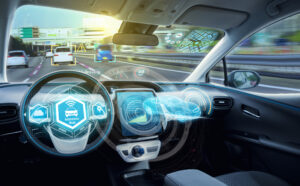
Vehicle technology is causing bad driving, study says
By onMarket Trends | Technology
Nearly one-third of drivers whose vehicles are equipped with advanced driver assistance systems (ADAS) believe new technologies are worsening their behind-the-wheel skills, according to new data from the United Kingdom.
The findings emerged from a survey by Quotezone, an auto insurance comparison site, and were reported on by a number of outlets.
The survey found that among the 66% of respondents whose vehicles contain ADAS features, 31% believe things, like assisted parking, speed control, and braking assist, are making them worse drivers.
“Our survey results show the majority of people have some sort of automated technology in their cars, and many of them are relying on it regularly when it comes to basic driving skills,” Greg Wilson, Quotezone CEO, told news outlets. “Things like parallel parking, timely braking, cruise control and navigation have all been taken out of the drivers control by automated car systems. This raises a question around whether this is making us worse drivers, considering many of us are no longer practicing driving skills to complete these, sometimes tricky, maneuvers.”
The survey found that among drivers:
-
- 15% admitted to “heavily relying” on ADAS features while on the road;
- 37% use advanced technologies because it makes driving easier;
- 50% use ADAS features every time they slip behind the wheel; and
- 25% rely on it to park.
“Within our survey, 12% said with the advanced car technology they found themselves looking away from the road more often,” Wilson said. “Drivers must ensure they are following [the rules] and that none of these assisted features are causing a distraction or lack of concentration.”
This isn’t the first time studies have highlighted overreliance on vehicle technologies.
An Insurance Institute for Highway Safety (IIHS) report from 2018 determined that drivers tend to change their behavior when using automated parking technology.
“Drivers adapt their glance behavior when using automation, which may detract attention from their surroundings,” IIHS said. “Glance behavior during parallel parking maneuvers performed with and without automated steering was compared. Drivers directed a smaller proportion of their glances toward the parking space and spent less time looking at it when using automation than when not using automation.”
A separate IIHS study from last October found that drivers who use partial automation frequently treat their vehicles as fully self-driving, confident that they can perform non-driving-related activities like eating or texting while behind the wheel.
Joseph Young, IIHS spokesman, said when considering the correlation between driving habits and technology, it’s important to distinguish between crash avoidance features and partially automated systems that take over some driving tasks.
“There isn’t any evidence that those crash avoidance technologies are leading to any diminished driving capabilities,” Young told Repairer Driven News. “On the contrary, we can see in the data that they are effective at preventing the crashes they’re designed to address and providing real benefits. For example, automatic emergency braking systems (AEB) cut rates of rear-end crashes by about half.”
He added that there is some concern that partially automated driving systems are leading to inattention among some drivers.
“The size of this problem isn’t clear, but there have been quite a few crashes in which it appears that the driver was not paying attention and instead allowing the system to do the driving for them,” Young said. “While none of the currently available systems are designed to let the driver check out, it’s clear that many drivers are doing just that.”
IIHS has responded by developing recommended safeguards for Level 2 systems and is in the process of launching a ratings program for how well automakers incorporate those safeguards, Young said.
“Our advice for drivers of vehicles equipped with partially automated systems is to remember that these systems are not replacements for an attentive driver,” he said. “While they perform well in certain conditions, these systems can quickly disengage or perform in an unexpected way. Drivers should keep their hands on the wheel and always remain attentive.”
Other studies have highlighted the value of driver assistance features as lifesaving tools.
A new study sponsored by the AAA Foundation for Traffic Safety found that ADAS technologies currently available to U.S. consumers are anticipated to prevent 37 million crashes, 14 million injuries, and nearly 250,000 deaths. That adds up to 16% of crashes and injuries and 22% of deaths that would otherwise occur on U.S. roads without these technologies, according to the study results.
“ADAS would be expected to prevent approximately 38% of all traffic fatalities that would have occurred in 2050 given current levels of ADAS effectiveness, uptake, and use, meaning that 62% of those fatalities (or approximately 27,000 fatalities) would still be expected to occur despite the anticipated ubiquity of ADAS by 2050,” the researchers said. “These findings are consistent with previous research cautioning that automated vehicle safety systems are unlikely to eliminate all or most traffic fatalities and injuries in the near future.”
Images
Main image: iStock/metamorworks
